Major Cell Types
- Fibroblast: most common type of cell, quite large, usually star shaped. function is to produce fibres.
- Macrophages: Almost as numerous as fibroblasts. Cells can move about and engulf and destroy foreign cells. Important defence against infectious agents.
- Mast: Widely distributed. Function not completely understood, but release substances important for the defence against foreign cells and particles.
Connective tissue fibre types
- Collagen: Quite thick, made of the protein collagen. Major structural protein of the body, flexible but only slightly elastic. Great tensile strength.
- Elastic: Made up of protein bundles (microfibrils) embedded in a protein called elastin. Less strength than collagen but very elastic. Easily stretched, but will resume original length and shape.
- Reticular: Very thin fibres made of collagen. Form delicate supporting networks.
Functions of Connective Tissue
- Bind structures together
- Support and protection
- Store fat
- produce blood cells
Loose aerolar Connective
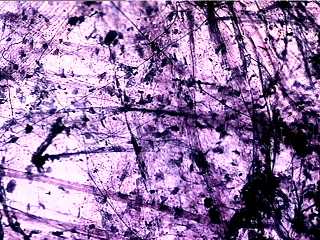
Identifying Features
- Nuclei visible -belong mainly to fibroblasts.
- Thick fibres visible are collagen.
- Thin fibres visible are elastic.
- All the above embedded in a gel like ground substance (not stained here)
Functions
- Binds organs together
- Holds tissue fluids, provides a reservoir of water and salts
- Universal packaging material between other tissues
Locations
Between muscles, forms subcutaneous tissues of skin, wraps small blood vessels and nerves, surrounds glands, forms laminar propria of mucous membranes.Dense Fibrous

Identifying Features
- Nuclei visible -belong to fibroblast cells
- Dense, closely packed thick collagen fibres
Function
Binds organs together.Locations
Ligaments, tendons, skin.Elastic

Identifying Features
- abundance of elastic fibres, note the wavy appearance
- few nuclei
Function
Gives elastic quality.Location
Between adjacent vertibrae, walls of airways.Adipose
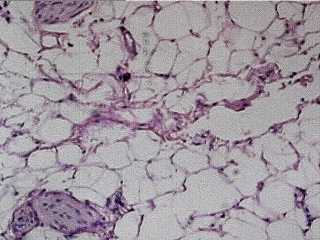
Identifying Feature
Large fat filled cells (nuclei not visible here, but usually squished to outside of cell). Compared to other connective tissues it is very cellular.Functions
- Insulation
- Protection
- Storage of fat
- Provides reserve food supplies
Location
Under the skin (subcutaneous tissue), around kidneys, bone marrow (yellow), behind the eyeballs, breasts.Hyaline Cartilage
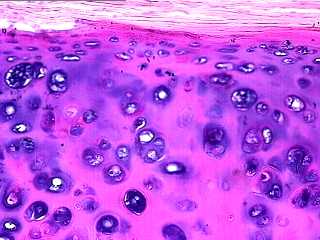
Identifying Features
- Cells called chondrocytes found in spaces called lacunae
- Background matrix contains no visible fibres (collagen fibres are actually present, but not visible)
Functions
- Provides pliable support
- Protection
- Provides framework
Locations
Ends of bones, parts of nose, walls of trachea, connects ribs to sternum, forms part of larynx, forms part of bronchial tree, epiphyseal plates.Fibro Cartilage
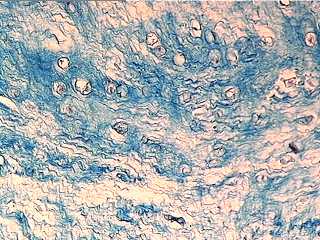
Identifying Features
- Fewer chondrocytes
- Abundance of collagen fibres
Functions
- Support that can withstand heavy pressures
- Protection
Location
Pubis symphysis of pelvic girdle, intervertebral disks, knee.Elastic Cartilage
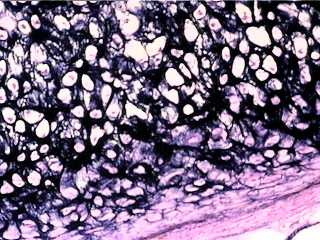
Identifying Features
- Chrondrocytes
- Abundance of elastic fibres (looks messy)
Functions
- Support with great ability to bend
- Protection
- Provides framework
Location
Makes up framework for parts of the ear, larynx and epiglottis.Reticular

Identifying Features
- Reticular Fibres present
- Cell nuclei visible belonging to reticular cells (a type of fibroblast)
Function
SupportLocation
Walls of liver and spleenBlood

Identifying Features
- Abundance of cells. Most cells are biconcave discs lacking nuclei (erythrocytes). Also visible is one white blood cell, this is the most common type of leucocyte called a neutrophil (note the lobed nucleus).
- Clear background matrix is the plasma, lacks any visible fibres.
Functions
- Transport of gases
- Fights infection
- Blood clotting
Location
Inside blood vesselsBone
Identifying Features
- Large cylindrical structures (Osteons or haversian systems)
- Smaller concentric layers (lamellae)
- In centre of haversian systems are canals (haversian canals). These appear as solid black circles.
- Small cells (osteocytes).
Functions
- Provide framework
- Site of attachment of tendons
- Storage site of calcium
- Protection
- Red marrow is site of blood cell production
Location (Compact bone)
This bone is found in the shafts of long bones.Tissue Index